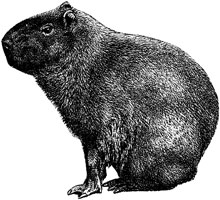|

R.O.U.S. (Rodent of Unusual Size): Full-grown capybaras reach between 105 and 135 cm (40–55 in) in length, and weigh 35 to 65 kg (75–140 lbs). Except for their large size, capybaras are similar to guinea pigs in appearance. Not only is the capybara the largest rodent, it also is more than 3 times the weight of the second largest living rodent, the beaver.

 Swim Champs: Capybaras are excellent swimmers, and have partially webbed feet. They mate in the water, use the water to hide from and elude predators, and can stay submerged for several minutes. Swim Champs: Capybaras are excellent swimmers, and have partially webbed feet. They mate in the water, use the water to hide from and elude predators, and can stay submerged for several minutes.
At Home in the Water: It is even possible for capybaras to sleep underwater, which they accomplish by leaving their noses exposed to the air.
A Herd of Giant Rodents: Capybaras are herd animals. The males of the species have a gland on their noses which exudes a liquid pheromone. In the mating season, they will rub this gland on the surrounding foliage to attract females. They spend most of their time on the banks of rivers, feeding in the mornings and evenings.
 On the Menu: In the wild they eat grasses and aquatic plants, melons and squashes. An adult capybara eats six to eight pounds of grasses a day. They need special adaptations to digest grass. One is a a large fermentation chamber in the intestines called the cecum. Another is that they eat some of their own droppings. On the Menu: In the wild they eat grasses and aquatic plants, melons and squashes. An adult capybara eats six to eight pounds of grasses a day. They need special adaptations to digest grass. One is a a large fermentation chamber in the intestines called the cecum. Another is that they eat some of their own droppings.
Home is where you have your habitat... They live in grasslands and forests alongside water, such as rivers and lakes.

Capybara Farms: Recently some farmers have started breeding capybaras for their meat. Capybara farms are most common in Venezuela, where capybara meat is a popular dish; but some are found in other countries, usually catering to specialty restaurants. The animals are prolific and relatively easy to raise.
 Beautiful Rodents: Capybaras are often kept for "decorative" purposes in public parks, farms, and tourist resorts which have access to suitable water bodies. The animals are usually allowed to roam freely; they adapt easily to human presence, and allow themselves to be petted and hand-fed. Beautiful Rodents: Capybaras are often kept for "decorative" purposes in public parks, farms, and tourist resorts which have access to suitable water bodies. The animals are usually allowed to roam freely; they adapt easily to human presence, and allow themselves to be petted and hand-fed.
Harbingers of Disease: However, in Southeast Brazil (states of São Paulo, Rio de Janeiro, and Minas Gerais) this custom has run into trouble recently, after
capybaras were found to be a reservoir for Rocky Mountain spotted fever.
The disease can be transmitted to humans by the star tick (Amblyomma cajennense), a common parasite of many animals — including capybaras and humans. Responding to pressure from health authorities and public opinion, many public places in those states have eliminated the capybaras they once kept.
Also Known As: The animal is also called capivara in Portuguese, and carpincho or chigüire in Spanish. The name originally derives from the Guarani word kapiÿva, meaning roughly "master of the grasses". In English, it is also sometimes called Water Hog.

All text is available under the terms
of the GNU Free Documentation License
|